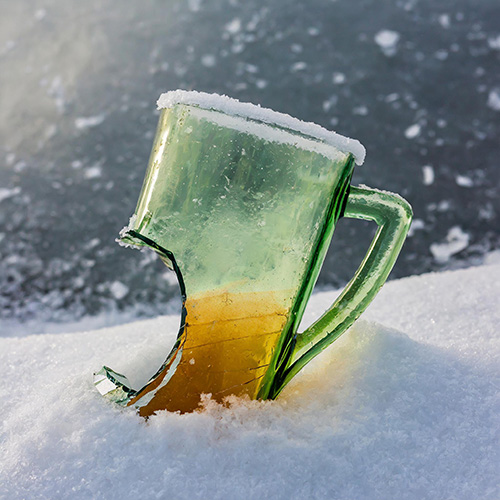In the Doghouse
Damped If You Do: Big Alcohol Moves to Absorb Dry January
 As January comes to an end, the most sophisticated minds in alcohol marketing have fallen back on the most basic strategy: name-calling. As Dry January, the cross-continental annual experiment with cutting out alcohol, comes to an end, so does the outsized coverage of “Damp January”. If the name seems unfamiliar, that could easily be because this was the year that it was pushed in force to stem industry losses to increasingly “sober curious” consumers.
As January comes to an end, the most sophisticated minds in alcohol marketing have fallen back on the most basic strategy: name-calling. As Dry January, the cross-continental annual experiment with cutting out alcohol, comes to an end, so does the outsized coverage of “Damp January”. If the name seems unfamiliar, that could easily be because this was the year that it was pushed in force to stem industry losses to increasingly “sober curious” consumers.
Though the phrase seems to have first appeared in print in January 2023, the Dry vs. Damp January difference was definitively staked out on January 8, 2024, by the New York Times. The paper wrote encouragingly about how “you can improve your health just by drinking less.” Experts were quoted. Various strategies were offered, including drink-tracking, changing social contexts, and alternating alcoholic and non-alcoholic drinks. In a vacuum, it seemed like a positive, encouraging article on healthier drinking habits, even if some otherwise sympathetic critics fully loathed the term.
But the reporting was not in vacuum. It was in the context of Dry January. The idea of starting the New Year sober originated with Alcohol Change UK, a charity dedicated to reducing alcohol harm. As original conceived, it was a formal campaign—participants took a pledge and stuck with it for a month, with the organization providing publicity and moral support. As it crossed the ocean, it became more informal, a pop-cultural experiment in self-care in which U.S. participants simply… did not drink. The result was an explosion of coverage of the health concerns of alcohol consumption in January, and perhaps associated developments such as the proliferation of alcohol-free nightlife and mocktail recipes.
As alcohol harm and industry profits both skyrocketed in the wake of the COVID-19 crisis, so did interest in reducing drinking—a possible backlash pattern in the face of an industry run amok. The industry in turn, responded in three ways: mocking and undermining it, profiting off it, and, with Damp January, conflating and assimilating it.
On the surface, Damp January—like nonalcoholic beers and mocktails—seems a laudable goal. Mindful consumption, the basic point of Damp January, is healthier than uncontrolled drinking, and, at least in concept, protective from binging and other dangerous behaviors. In fact, the tenets of Damp January should be the goal for anyone who drinks alcohol: stick to the planned number of drinks, don’t drink in ways that cause short- or long-term damage, and be aware of your own habits.
The problem—and the suspicion that the emergent concept was seeded by industry—comes from Damp January being the alternative to Dry January. Despite the parallel naming, the goals of the two Januarys are disaligned. The intention of Dry January, despite the way Damp January proponents frame it, is not to go to war with your instincts to drink. It is to pay attention to how you feel when cut out alcohol. The assumption is that the experience of going without alcohol will be self-encouraging.
Damp January, by contrast, turns the focus away from the self and one’s own happiness to the process of wrangling your own habits. It is presented in a way that directly challenges the self-efficacy in cutting alcohol out. Damp January is for those who cannot, whereas Dry January—particularly as an organized campaign, but also by creating informal support networks—centers on the message “You can.” And, most significantly, Damp January is directly promoted by the alcohol brands themselves, who stand to benefit from consumers opting to pursue it instead of its Dry cousin. Benefit more, certainly, than the consumers do.
That said, intentionality in alcohol consumption should be actively encouraged. It just should not be encouraged at the cost of experiments in non-drinking. A Mindful May, a Deliberative December, a Slow-Sipping September—there are 11 other months to appropriate that do not directly conflict with a growing movement to test the driest waters. In the meantime, hats off to those who just finished their 31 days, and congrats to those looking ahead to 2025.
READ MORE about industry backlash at Dry January
READ MORE about the paradox of the NA market
Dunkin' Spiked Brings Shame to Ben Affleck
 In terms of bleak and reckless ways to bring in young drinkers, the legacy of the 2020s will almost certainly be the boozification of backyard brands. Alcoholic sodas are the most obvious form this trend takes, with everything from Coca-Cola to Mountain Dew to Monster Energy being sold in an ABV incarnation. The pitch for these products is that adults are clamoring for a product they loved as kids packaged with an intoxicating kick. Yet the key word here is "kids," since if grown-ups loved Mountain Dew as kids, actual kids love it even more. All the more so since sugary beverage companies have fought for decades to make sure their vending machines are in elementary and high schools. And the trend keeps spreading: Dunkin' Donuts, a company whose brand should be synonymous with mornings but has instead (for reasons that are beyond the reach of science) become synonymous with Ben Affleck, has rolled out an alcoholic version of its iced coffee.
In terms of bleak and reckless ways to bring in young drinkers, the legacy of the 2020s will almost certainly be the boozification of backyard brands. Alcoholic sodas are the most obvious form this trend takes, with everything from Coca-Cola to Mountain Dew to Monster Energy being sold in an ABV incarnation. The pitch for these products is that adults are clamoring for a product they loved as kids packaged with an intoxicating kick. Yet the key word here is "kids," since if grown-ups loved Mountain Dew as kids, actual kids love it even more. All the more so since sugary beverage companies have fought for decades to make sure their vending machines are in elementary and high schools. And the trend keeps spreading: Dunkin' Donuts, a company whose brand should be synonymous with mornings but has instead (for reasons that are beyond the reach of science) become synonymous with Ben Affleck, has rolled out an alcoholic version of its iced coffee.Again, it cannot be emphasized too strongly: Dunkin's signature product is a donut. A cheap dessert, that, by their own report, is favored by "families [and] students," and whose afficionados skew young. This demographic is crucial to the alcohol industry. The younger someone starts drinking, the more likely they are to engage in disordered drinking when they are older--binge or heavy drinking patterns that are dangerous to them and lucrative for the industry.
Considering the financial stakes and the waning interest in alcohol displayed by younger generations, it should not be surprising that the industry surges for any excuse to initiate new drinkers. The resulting "ABV creep" continues to pull in more and more product lines. Not only does it threaten to result in an alcoholic version of every product youth have ever liked (the idea that an adult would eagerly lap up an alcohoic Sunny Delight embarrasses everyone involved), it creates immediate consumer confusion wherein both kids and adults could buy and try the alcoholic version by mistake.
The only thing that will stop boozey everyday products is burnout, and it's quite possible the industry is heading that way. Certainly Ben Affleck seems exasperated. More concerning, however, is the breakdown of both social and regulatory norms allowing donuts and double whiskey sours to become synonymous. After all, identifying, exposing, and regulating tobacco industry strategies for drumming up youth interest turned out to be key to reining in the harms from cigarette smoking. The hope now is that communities, decisionmakers, and regulatory bodies will wake up to the Big Alcohol's relentless quest for young livers.
READ MORE about how convenience store environments encourage youth use.
READ MORE about Big Soda's rush to become Big Alcohol.
The Cruel Trade: With AB 840, Big Alcohol Buys Underage Eyes
The alcohol industry is running an experiment, of the kind sometimes carried out in college psych labs. In this experiment, a young student—19 or 20 years old—is shown a lever. The experimenter urges them to pull it. If they do, they are subjected to a random outcome: they might feel happy, or nauseous, or they will receive a shock, and, rarely, killed.
 This seems absurd, cruel, and reckless, a deeply unethical experiment, even more so if it happens to be run at the financial behest of a donor. But at Big Alcohol's behest, Cal Poly San Luis Obispo is doing just that kind of experiment. They are pushing to be allowed to sell alcohol advertising throughout the recreational facilities used by the school’s undergraduates, many of whom are below the legal drinking age.
This seems absurd, cruel, and reckless, a deeply unethical experiment, even more so if it happens to be run at the financial behest of a donor. But at Big Alcohol's behest, Cal Poly San Luis Obispo is doing just that kind of experiment. They are pushing to be allowed to sell alcohol advertising throughout the recreational facilities used by the school’s undergraduates, many of whom are below the legal drinking age.
“Alcohol ads are not neutral,” said Cruz Avila, Executive Director of Alcohol Justice. “They are meant to persuade, and they don’t ID someone before they persuade them. As a father who has studied and researched the consequences of reckless drinking on underage Californians, it’s unforgivable that a school would sell its students to Budweiser for pocket change.”
Cal Poly, along with seven other California State University campuses as well as St. Mary’s College of California, are sponsors of AB 840, a bill authored by Democratic Assemblymember Dawn Addis that will let the universities sell space to alcohol advertisers in stadiums and event centers. The universities are pushing for this in a desperate scrounge for funding. In testimony before the California Senate Governmental Operations Committee, Cal Poly Assistant VP of Strategic Business Services Dru Zackmeyer noted that “operating budgets are always tight. Sponsorships with local alcoholic beverage suppliers and manufacturers based in part on advertising opportunities… provide hundreds of thousands of discretionary dollars.”
Yet Zackmeyer also acknowledged that these advertising policies would not just put college students in the crosshairs. University facilities serve as community hubs, including for youth gatherings. Zackmeyer noted that the Cal Poly Performing Arts Center would be a beneficiary of these ads, and would in turn spend that money to “allow 12,000 K through 12 students to experience live educational arts performances.”1
The rationale—market alcohol to middle schoolers so you can maintain a facility to market alcohol to middle schoolers—would be merely bleak if it were financially effective. But the actual effectiveness of this strategy was questioned by the California Assembly Appropriations Committee analysis which noted the yearly revenue would be “…potentially in the low millions of dollars annually.” For context, the CSU System budget is $12.4 billion per year. And this is only cost neutral if, in fact, alcohol advertising has no effect, particularly on the 40% of the CSU system under 21.2 Research shows, however that this is not the case.
Alcohol marketing absolutely impacts underage young adults. Studies have shown that exposure to alcohol ads increases intention to drink and likelihood of binge drinking3—and an 18-year-old high school senior is just as vulnerable to this as an 18-year-old college freshman. When you raise alcohol consumption in this cohort, you raise the consequences, and those consequences range from uncomfortable to lethal.
Alcohol consumption in college is associated with a range of concerns, according to the National Institute on Alcohol Abuse and Alcoholism. Aside from simple academic problems as a consequence of drinking, collegiate alcohol use is associate with legal problems, violent assault, and sexual assault.4 In the worst case, alcohol can become a killer.
Or to look at it the other way, when the worst case occurs, it very likely derives from alcohol use. The top three causes of death for those underage are alcohol related: motor vehicle crashes, homicide, and suicide.5 As the opioid crisis bleeds into all facets of modern life, so too do alcohol-involved overdoses spike among young people. In these cases, alcohol’s tendency to make the body more sensitive to opioids and other downers turns nonlethal doses fatal.
It is easy but callous to brush these aside as the consequences of individual bad decisions. And historically, Big Alcohol has used that framework to avoid regulation that could reduce these life-altering outcomes.6 But in the case of college students, the consequences are often imposed by the university itself. Most universities have codes of conduct that preclude underage drinking on campus, with consequences up to and including expulsion.
“It is absolutely Kafkaesque to urge someone to do something that you intend to punish them for,” said Carson Benowitz-Fredericks, Research Director at Alcohol Justice. “It’s frankly cruel for CSU to take money to urge 19-year-olds to drink, suspend them for listening, and then tell them it’s all for their own benefit.”
Because of the harm to students from drinking and the harm to the university from students leaving the system, it becomes increasingly difficult to realize the economic advantage. At last estimate, underage drinking cost California $7.3 billion, including underage college students.7
The CSU system still fights its own battles against rampant disruption and death due to alcohol, as exemplified by the plight of San Diego State University in the wake of its own exemption from alcohol advertising restrictions.8 And the system at large has dedicated $25 million—far, far more than will be brought in by advertising to its students—to address rampant sexual misconduct concerns.9 Since so many of these consequences are tied to drinking, it puts CSU in a bind.
Either:
- The alcohol advertising is ineffective, in which case the ads will be pulled and they will lose the money, or
- The alcohol advertising is effective, in which case consumption goes up, the costs and fallout goes up, and CSU loses more money than it raises.
The alcohol industry clearly thinks the advertising will work. Industry documents show they are well aware that their products and campaigns capture the attention of people who are too young to drink.10 By simply splashing them up in a mixed crowd—40% underage, 60% legal age—they can claim they were only trying to market to those 21 years of age and older. Worse, AB 840 gives Big Alcohol permission to violate even their own voluntary marketing restrictions. When asked to set a limit for underage audience for alcohol ads, the industry vowed not to use a channel where more than 28.4% of the audience was underage.11 The audience at CSU, of course, is 40% underage.
“I can see the industry saying, ‘If CSU doesn’t care, why should we?” said Michael Scippa, Public Affairs Director for Alcohol Justice. “If CSU doesn’t care about kids dropping out, crashing their cars, getting assaulted… why should Big Alcohol?”
Alcohol Justice and the California Alcohol Policy Alliance ask concerned community members to reach out to Assemblymember Addis, representatives at Cal Poly, and legislative leaders in Sacramento, to tell them to stop sacrificing youth on the altar of alcohol industry profits. This has hurt too many California kids before and will do it again. Whatever the money offered, the real price is too steep.
To send a message to Sacramento, TAKE ACTION here: http://bit.ly/44n481d
REFERENCES
1. California State Senate Governmental Operations Committee. July 11, 2023 legislative session. Available at: https://www.youtube.com/watch?v=6rttXJJUIHE. (Comments start at 1’18”.)
2. California Polytechnic State University. (2023). “Institutional Research.” Available at: https://ir.calpoly.edu/content/publications_reports/polyview/index. Accessed August 11, 2023.
3. Jernigan, D., Noel, J., Landon, J., Thornton, N., & Lobstein, T. (2017). Alcohol marketing and youth alcohol consumption: a systematic review of longitudinal studies published since 2008. Addiction, 112, 7-20.
4. National Institute on Alcoholic Abuse and Alcoholism. (2023). “Harmful and Underage College Drinking.” Available at: https://www.niaaa.nih.gov/publications/brochures-and-fact-sheets/college-drinking. Accessed August 11, 2023.
5. Centers for Disease Control and Prevention. CDC WONDER. Available at: https://wonder.cdc.gov/. Accessed August 11, 2023.
6. Mialon, M. & McCambridge, J. (2018) Alcohol industry corporate social responsibility initiatives and harmful drinking: a systematic review. European Journal of Public Health, 28(4), 664-73.
7. Miller, TR, Levy, DT, Spicer, RS, & Taylor, DM. (2006) Societal costs of underage drinking. Journal of Studies on Alcohol, 67(4) 519-28.
8. Ramirez, J. “Vodka Billboard with SDSU Athletics Logo Stirs Controversy.” November 15, 2022. CBS. Available at: https://www.cbs8.com/article/news/local/vodka-billboard-with-sdsu-logo-stirs-controversy/509-2224c972-a3d1-44e5-8019-e7d484de43b9. Accessed August 22, 2023.
9. Zinshteyn, M. “How Many Cal State Employees Are Accused of Sexual Harassment? Here’s Why It’s Hard to Know.” August 7, 2023. Cal Matters. Available at: https://calmatters.org/education/higher-education/2023/08/sexual-harassment/. Accessed August 22, 2023.
10. Hill, S.C., Thomsen, S.R., Page, R.M., & Parrott, N. (2005). Alcohol advertisements in youth-oriented magazines: Persuasive themes and responsibility messages. Journal of Health Education, 36(5), 258-265.
11. Beese, J. “Please Link Responsibly: Social Media Guidelines for Alcohol Marketing.” March 30, 2015. Sprout Social. Available at: https://sproutsocial.com/insights/social-media-alcohol-marketing/. Accessed August 11, 2023.
More Articles ...
Help us hold Big Alcohol accountable for the harm its products cause.
| GET ACTION ALERTS AND eNEWS |
STAY CONNECTED    |
CONTACT US 24 Belvedere St. San Rafael, CA 94901 415-456-5692 |
SUPPORT US Terms of Service & Privacy Policy |


